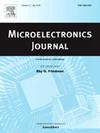A reconfigurable MRAM PUF with high reliability
IF 1.9
3区 工程技术
Q3 ENGINEERING, ELECTRICAL & ELECTRONIC
引用次数: 0
Abstract
Physical unclonable function (PUF) has been increasingly applied in the Internet of Things (IoT) fields due to its high security. With the emergence of novel devices, magnetoresistive random access memory (MRAM)-based PUF technology offers excellent energy efficiency and integration density. However, it falls short in terms of response reliability. To address this issue, in this paper, we propose a high-reliability reconfigurable MRAM PUF. First, we propose a novel reconfigurable PUF cell based on the characteristics of MRAM devices. Then, we introduce a sleep mode to reduce the power consumption of PUF. Moreover, we propose a resistance configuration strategy in conjunction with the configurable features of MRAM, which further enhances reliability without increasing hardware overhead. The design is simulated and tested in the SMIC 40 nm process. Experimental results demonstrate that the proposed PUF has a uniqueness of 50.02% and a uniformity of 49.98%, both of which are close to the ideal values. Finally, the bit error rate (BER) is less than 2.2% under temperatures of −40 120 °C and voltages of 0.7 1.4 V, which effectively improves the reliability.
具有高可靠性的可重构MRAM PUF
物理不可克隆功能(PUF)以其高安全性在物联网领域得到越来越多的应用。随着新型器件的出现,基于磁阻随机存取存储器(MRAM)的PUF技术提供了出色的能量效率和集成密度。然而,它在响应可靠性方面存在不足。为了解决这个问题,在本文中,我们提出了一个高可靠性的可重构MRAM PUF。首先,我们提出了一种基于MRAM器件特性的新型可重构PUF单元。然后,我们引入睡眠模式来降低PUF的功耗。此外,我们提出了一种结合MRAM可配置特性的电阻配置策略,该策略在不增加硬件开销的情况下进一步提高了可靠性。该设计在中芯国际40纳米工艺下进行了仿真和测试。实验结果表明,所提PUF的唯一性为50.02%,均匀性为49.98%,均接近理想值。最后,在−40 ~ 120°C温度和0.7 ~ 1.4 V电压下,误码率(BER)小于2.2%,有效提高了可靠性。
本文章由计算机程序翻译,如有差异,请以英文原文为准。
求助全文
约1分钟内获得全文
求助全文
来源期刊

Microelectronics Journal
工程技术-工程:电子与电气
CiteScore
4.00
自引率
27.30%
发文量
222
审稿时长
43 days
期刊介绍:
Published since 1969, the Microelectronics Journal is an international forum for the dissemination of research and applications of microelectronic systems, circuits, and emerging technologies. Papers published in the Microelectronics Journal have undergone peer review to ensure originality, relevance, and timeliness. The journal thus provides a worldwide, regular, and comprehensive update on microelectronic circuits and systems.
The Microelectronics Journal invites papers describing significant research and applications in all of the areas listed below. Comprehensive review/survey papers covering recent developments will also be considered. The Microelectronics Journal covers circuits and systems. This topic includes but is not limited to: Analog, digital, mixed, and RF circuits and related design methodologies; Logic, architectural, and system level synthesis; Testing, design for testability, built-in self-test; Area, power, and thermal analysis and design; Mixed-domain simulation and design; Embedded systems; Non-von Neumann computing and related technologies and circuits; Design and test of high complexity systems integration; SoC, NoC, SIP, and NIP design and test; 3-D integration design and analysis; Emerging device technologies and circuits, such as FinFETs, SETs, spintronics, SFQ, MTJ, etc.
Application aspects such as signal and image processing including circuits for cryptography, sensors, and actuators including sensor networks, reliability and quality issues, and economic models are also welcome.
 求助内容:
求助内容: 应助结果提醒方式:
应助结果提醒方式:


